Normally, when roots start coming out of the pot, you know it’s time to upgrade to a bigger container.
It’s a sign that your plant has outgrown its current home, and it needs to move to something with some more space. But what about orchids?
These aren’t your average plants. They’re quite unique compared to most other houseplants, as you probably surmised. Maybe their unusual blossoms alone were enough to tip you off!
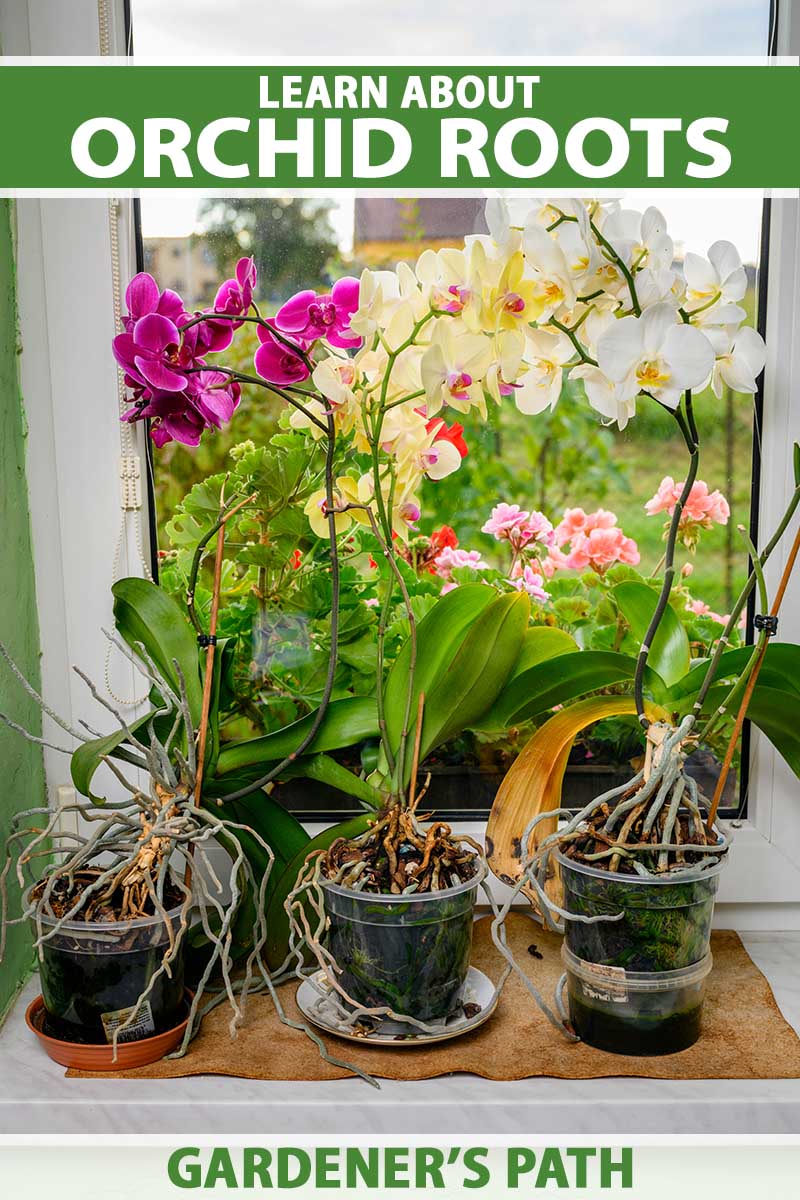
We link to vendors to help you find relevant products. If you buy from one of our links, we may earn a commission.
With orchids, roots growing out of the pot can actually be a good sign. It means your plant is healthy and growing as it should be, similar to how it would be in nature.
Does that mean your plant needs them? What if you think they’re a bit ugly? Can you ditch them to clean up the look of your houseplant, or does it mean you have to repot?
We have the answer to all those questions and more coming up in this guide.
If you’d like to know more about these funky growths, including what they do for the plant and why you should probably reconsider sending them to the compost heap, keep reading.
Here’s a quick look at everything we’ll discuss up ahead:
What You’ll Learn
Most orchids are epiphytes, which are plants that grow on other plants.
They aren’t parasites that draw nutrients or water from the host plant, however.
They just hang out on the bark and in nooks and crannies of the host plant, and use it as a base of support high off the ground.
Because they don’t grow in the ground like most plants, they’ve developed some unique methods of gathering moisture and food.
When you see extra growth coming out of the container, it’s usually related to this special adaptation. Let’s learn more about these growths.
What Are These Growths and Why Are They Here?
So, what’s up with these growths that you’re seeing, and what does it have to do with being an epiphyte?
Since epiphytes don’t grow in a big bunch of soil that can hold water until they need it, they have adapted other methods to draw in water.

Staghorn ferns have adapted by growing fine hairs on their fronds to catch water, and orchids developed their own adaptations to absorb all the good stuff from the air.
Orchids have two kinds of roots: aerial and “normal” ones.
The second type is the same kind that most ground-dwelling plants have, and they act in the same way, by growing in the leaf litter and other matter that gathers in the crooks of branches and cracks in the bark where epiphytic orchids grow.
Terrestrial types have the same “normal” roots for growing in the soil.
But the aerial type is far less common and usually seen on plants that grow without a soil substrate in trees or on rocks.
Aerial types are there because orchids grow attached to trees without traditional soil.
They have these roots to help them nab additional moisture and nutrients from the air, and they provide additional anchoring for the plant. Imagine clinging to a tree all day. You’d want some additional support.
So how do the aerial growths help capture additional water and nutrients if they don’t anchor in the decaying matter that the plant uses as its nutrient base?
These growths are covered in a special spongy outer layer made up of dead cells. This skin is known as the velamen radicum and it should be white, silvery, or gray if it’s healthy. When it’s moist, it becomes green.
A few other epiphytes, such as Monstera species, have velamen, too.
Once the velamen soaks up some water and nutrients, the veins of the orchid, known as steles, draw in the moisture and send it out to the regular roots, stems, and leaves.
Don’t confuse aerial roots with flower spikes.
They can look similar, especially when they’re young. Flower spikes have a bud at the end that looks like a bunch of bumps. Aerial roots have smooth ends.
What Should I Do with Them?
The short answer is: nothing!
If your plant has these growths, there’s nothing you need to do. For the most part, aerial roots are a sign that your plant is perfectly healthy and just doing its thing.
It doesn’t mean the orchid is unhealthy or that it has outgrown its pot.
These growths can actually be a good indicator of when your plant should be watered. Think of them like a built-in hygrometer.
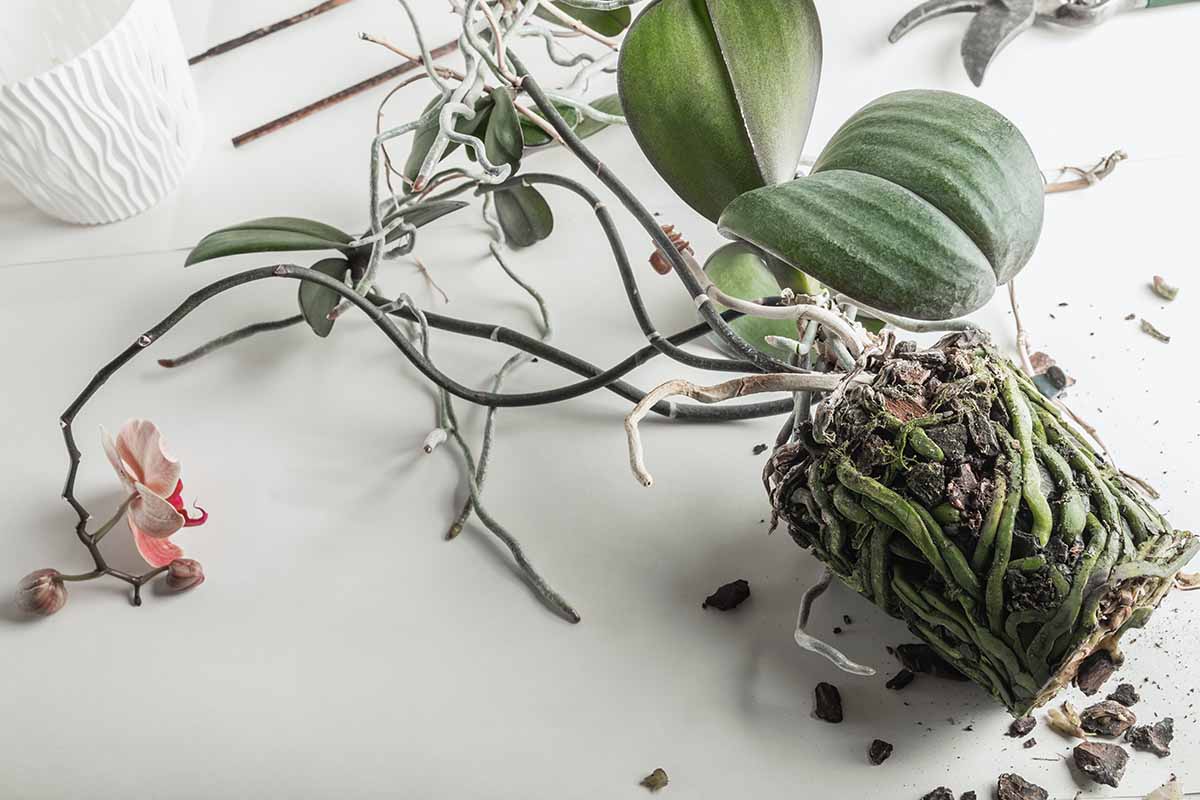
If the aerial roots near the base of the plant touching the growing medium are green, they’re wet, and the plant doesn’t need water. If they’re silver or white, you can go ahead and add more water.
This doesn’t work as well with those growing higher up on the plant since they dry out faster without access to the moisture in the growing medium.
If any of those aerial growths are shriveled up, brown, or show any fungal growth, this is a good indication that they’re dead or dying. And this is probably because you overwatered, which is incredibly easy to do with orchids.
Dead or diseased growths can be trimmed off, but healthy growth should be left alone. Removing aerial roots reduces the amount of water that’s able to reach the plant. It grew those for a reason, right?
So can you just trim them off and give your plant more supplemental water to make up the difference? Nope. If you do that, you run the risk of overwhelming the existing roots, leading to rot from overwatering.
Removing them also introduces an opening for viruses, bacteria, and fungi.
Truly, if you can stand it, leave these growths alone as long as they appear healthy.
Trimming Aerial Roots
Let’s say you do need to trim off those aerial roots for whatever reason. Maybe they’re sick or broken. How do you go about it?
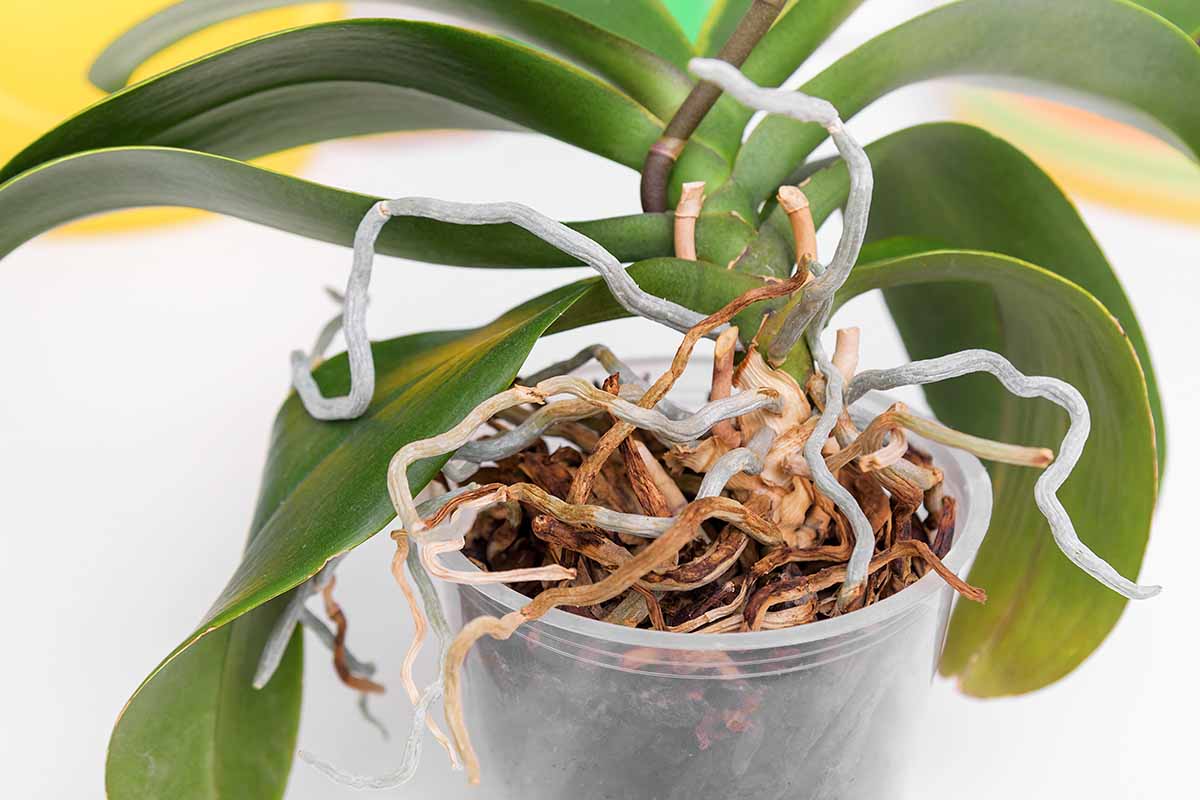
Find a pair of scissors and clean them with soap and water or rubbing alcohol. You always want to use clean tools to avoid spreading disease. Then, let them dry or dry them off.
Carefully lift up the aerial root and follow it to the base. They can be twisted up or entangled, so this is easier said than done.
Remember those maze games you used to do as a kid? It’s kind of like that. Once you solve the puzzle, use the scissors to snip away the root at the base.
For the next few weeks, you’ll want to keep a really close eye on the spot where you did the trimming and observe the overall plant to make sure nothing has snuck in to attack your specimen. Look for spots, discoloration, fungal growth, and black, mushy bits.
If you run into any of these, our orchid growing guide provides tips for dealing with common diseases.
What if Normal Roots Are Growing Out of My Orchid Pot?
This is another possibility. These won’t be the silvery white aerial ones coming out of the medium at the top of the root ball where the stem meets the roots.
These are the ones that start peeking out of the holes in the pot. These growths are darker, and they may be brown or yellow.
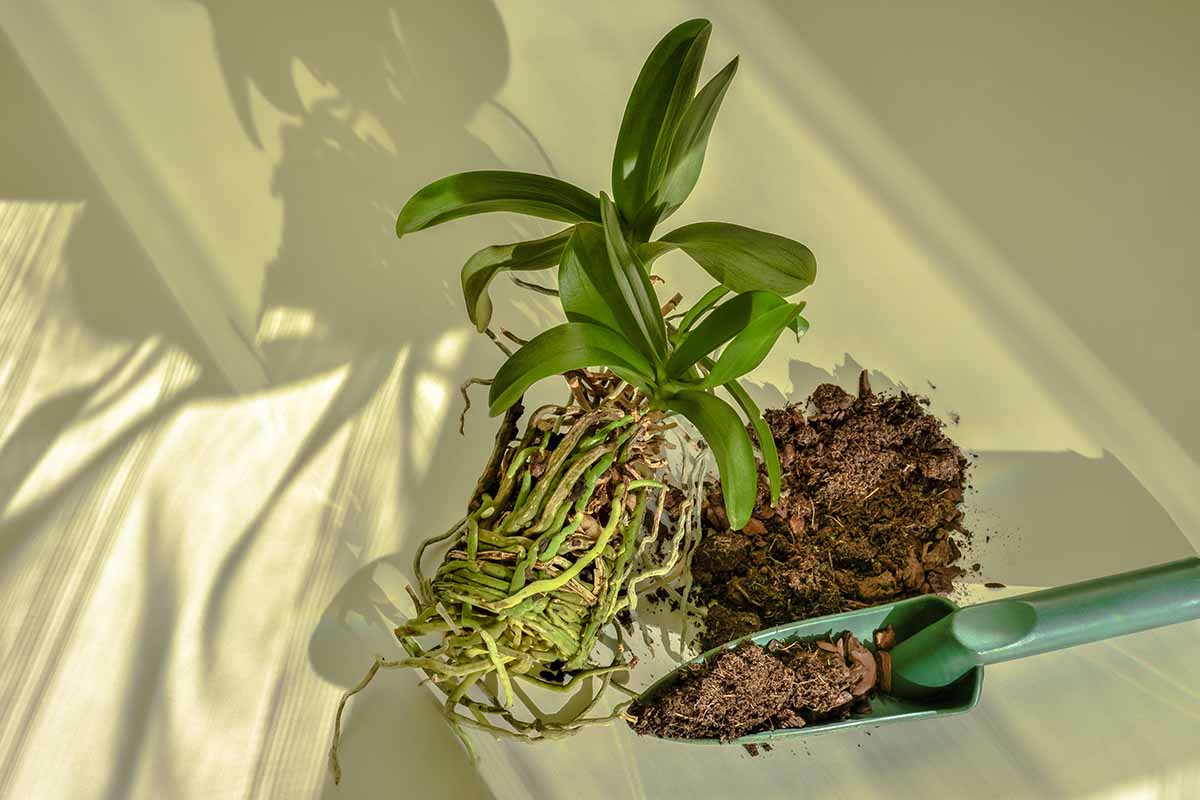
Now, if you have normal roots coming out of the holes in the container, you should repot the orchid in a bigger pot or, better yet, mount it.
If you don’t love the look of a bunch of aerial roots sticking out all over the place, mounting your orchid gives you a chance to arrange them in a manner that’s a bit more pleasing. Just don’t tuck them into the moss when you mount.
When repotting, just go up one size and make sure to pick a container with lots and lots of drainage holes. The more, the better.
We have a detailed guide to repotting orchids here.
Embrace Those Roots
Orchid roots are usually nothing to worry about. If you see them crawling out of your plants unexpectedly, it’s typically no big deal. Just know that your plant is doing what it does naturally.
Worst case scenario, you might just need to do some repotting.
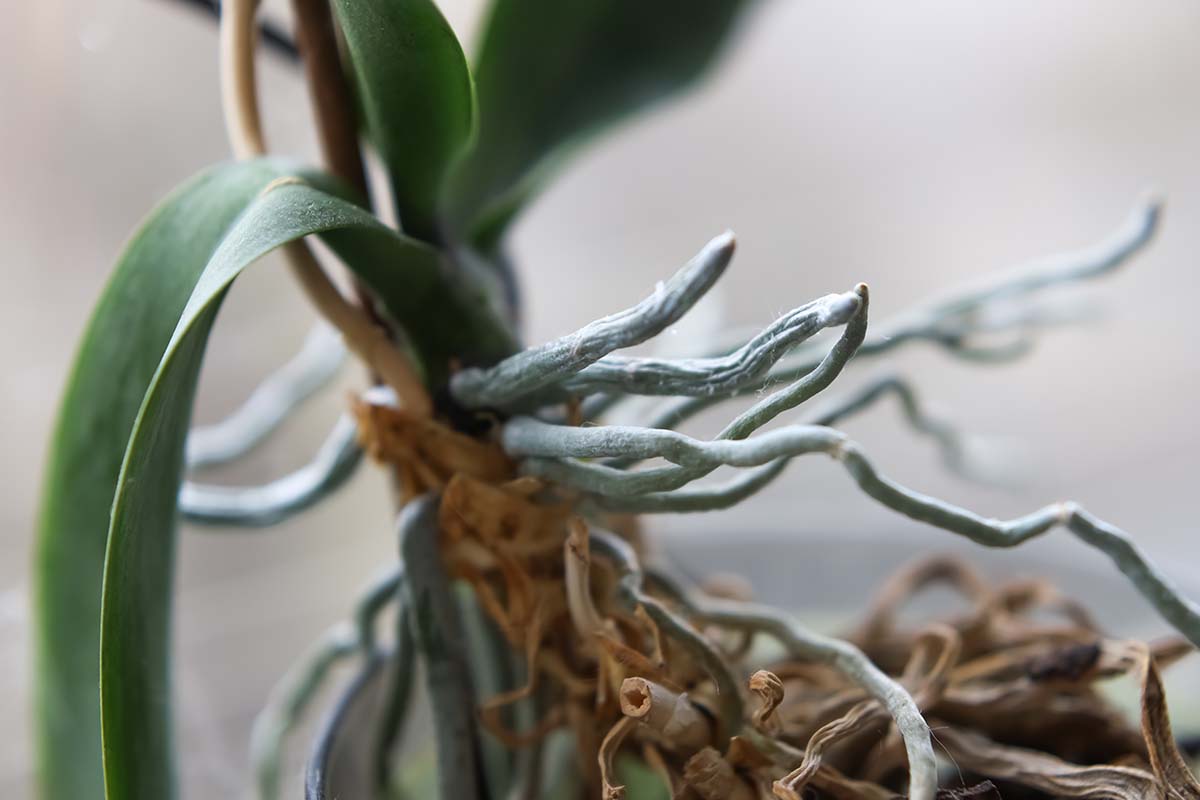
Orchids are such fascinating plants. How long have you been growing them? What species are you growing? Share your experiences with us in the comments section below.
There’s a lot more to know about growing orchids. If you’re interested in learning more, you might enjoy the following guides:


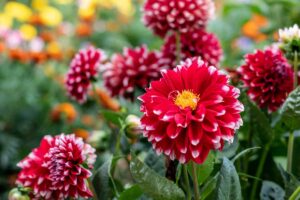
Orchids are beautiful plants. My plant is putting out new silvery sprout which is where the bloom comes from. But to me it need to be repotted. I have had it for two years, someone else had it before me, for how long I don’t know. It has the white blooms. Should I repot it? With some wood chips, à little potting mix and maybe some perlite. I don’t want to lose my plant, and I am very new to orchids. What looks like it’s in is a little dirt maybe a few chips of wood I don’t know. Can… Read more »
Hi Rebecca, thank you for your kind words! Based solely on how long it has been since your orchid was repotted, I would say it’s time. Don’t use any potting mix. An orchid bark mix is perfectly good. I like one that contains coco coir or bark, pine bark, and perlite or sponge rock. Something like this mix from Perfect Plants at Amazon is just right.
Normally, you want to look for roots coming out of the drainage holes or pushing the plant up and out of the pot. Those are both signs it’s time to repot.
I also wanted to include that your tutorial are very helpful and, so interesting. I love listening hearing what you have to say. As I stated orchids are foreign to me and I think in some ways make me little nervous afraid I’ll mess up and damage or kill it this is why I am reaching out to.
Hi Kristine I talked to you last time about my staghorn my husband was taking care of for me and it got black mold. Well, he also washed the leaves and thought that would help. Anyway, I have been growing phalaenopsis for over 10 yrs in two bedroom windows and recently got gnats and they killed my 17 plants in the one room, as hard as I tried to get rid of them. I cried when some of them died that I had for 15 yrs. The other room I have been able to save them all. Can you please… Read more »
Hello Brook, I’m so sorry to hear that. How awful. I’m happy to help, but I’ll need some additional information. Typically, fungus gnats don’t typically kill plants outright unless you have a serious infestation. Could you describe the pests that you’ve been seeing? Do they fly up when you walk by? Do they typically hang out on the bottom of leaves? You might actually be dealing with whiteflies, which can be very damaging. Take a look at our guide to whiteflies, and let me know if any of these seems to fit what you’ve seen. Or, do they tend to… Read more »
Hello, I have a moth orchid that just finished blooming and it needs a bigger pot.
Problem is, my aerial roots have come through all 4 sides and the bottom. There is no way to repot it without sacrificing the pot. Is that my best solution?
I can send pictures if you will give me an email.
Thank you!
Feel free to upload your photos here if you like, Kristy! Just click on the paperclip icon and select your photos.
This article is so helpful! I thought the long, grey “tentacles” meant I needed to repot but couldn’t imagine how big the pot would have to be to accommodate them. 😏 I bought a couple of orchids a few years ago. They’re side by side, both healthy. One has flowered twice since the original ones came off; the other hasn’t, but appears healthy. Then I bought a little one with tiny flowers. Then I rescued one some neighbours abandoned in the lane when they moved. We’ll see if I get more flowers but honestly, I am quite happy not to… Read more »
Hi Kat, thank you for the kind words! It sounds like your plants are doing great! Just the fact that one has rebloomed is a sign that you’re treating them well. Some need special conditions to rebloom. We have a guide to orchid reblooming if you’re interested in learning more.
There are new orchid plants growing on old flower stems–Some have 4 roots–Do I plant them? I like using moss the best.
Hi there, you can absolutely plant these plantlets. Remove them with a sterile knife and plant them in moss and they should continue developing into independent plants.
I use slotted pots for my orchids, but the roots grow out of the slots on the sides and bottom, preventing me from getting the plant out of the pot to put it in a larger pot. Do I cut these roots? If so, how is the best way?
Hi JB, this is a common issue. If you can’t push the roots out of the slots, you can either cut the plastic pot if you don’t plan on reusing it or you can cut off the roots. The plant will recover so long as you aren’t removing more than a fourth of the roots at one time.
Hi! I have an orchid that I think has wood surrounding its stem. It looks a lot like the fuschia orchid shown at the top of the page that’s to the left of the trio of orchids. Is this something to be concerned about? I have had my orchid for 2 and 1/2 years. I haven’t seen this happen before. I typically have flowers regrowing twice a year (even in the winter, which is nice). Anyway, I can’t find any info about a woody stem anywhere, so I’m assuming this isn’t common.
Hi Angela, it’s hard to say what’s going on. Could you send in a picture? I’m assuming you have a phalaenopsis and they definitely don’t have woody stems. It could be a dry root or something, but I really couldn’t say without seeing it.
I have loved orchids for a long time and i just recently git two orchid plants one is pretty big with two i velieve orchid stems in it and one is small like maybe the first bloom. I have watched videos and read but im still not fully sure how to care for them. I did learn however that they need dufferent tyle of potting mix snd good thing cause j was about to re pot them cause they looked over rooted and the smaller one is in a size of container similar to a solo cup size.
Hi Tabitha, orchids require different care than traditional houseplants and it can take some time to get familiar with their needs. You might want to check out our growing guide for some helpful information.